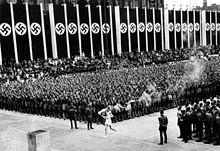Olympic flame
That lantern was then taken by French swimmer Léon Marchand from Jardins des Tuileries (where the Olympic cauldron, that was extinguished at that moment, was located) and ceremonially "transferred" to the Stade de France at the start of the Closing Ceremony; there it was finally extinguished just after the IOC president officially closed the Games.[4] This tower was associated with the marathon race and all its elements, including the fire, were an idea of the architect Jan Wils who also had designed the stadium.A group of women representing the Vestal Virgins[notes 1] (usually 11 in number) perform a celebration at the Temple of Hera, during which a fire is kindled by the light of the Sun, its rays concentrated by a parabolic mirror.Where cloudy weather prevents the use of the parabolic mirror on the day of the ceremony (as in 2024), a backup flame is used that has been lit during a prior dress rehearsal.[11] An actress plays the role of the temple's high priestess and presents the torch and an olive branch to the first relay bearer, usually a Greek athlete who has already qualified to compete in that edition of the Games.[16] At the first Olympic torch relay, the flame was transported from Olympia to Berlin over 3,187 kilometers (1,980 miles) by 3,331 runners in twelve days and eleven nights.Nazi Propaganda Minister Joseph Goebbels commissioned filmmaker and propagandist Leni Riefenstahl to film the event.[17] In the 1956 Melbourne Games in Australia, local veterinary student Barry Larkin protested against the relay when he tricked onlookers by carrying a fake flame, consisting of a pair of underpants set on fire in a plum pudding can, attached to a chair leg.Thus, the fires contained in the torches and Olympic cauldrons all trace a common lineage back to the same Olympia lighting ceremony.There is a highly visible (yellow flame) portion that burns cooler and is more prone to extinguish in wind and rain, but there is also a smaller hotter (blue in the candle's wick) flame akin to a pilot light hidden inside the torch which is protected from wind and rain and is capable of relighting the cooler, more visible portion if it is extinguished.The climactic transfer of the Olympic flame from the final torch to the cauldron at the central host stadium marks the symbolic commencement of the Games.At the 2012 Games in London, the torch was carried by Sir Steve Redgrave to a group of seven young British athletes (Callum Airlie, Jordan Duckitt, Desiree Henry, Katie Kirk, Cameron MacRitchie, Aidan Reynolds and Adelle Tracey) — each nominated by a British Olympic champion — who then each lit a single tiny flame on the ground, igniting 204 copper petals before they converged to form the cauldron for the Games.The first well-known athlete to light the cauldron in the stadium was the ninefold Olympic Champion Paavo Nurmi, who excited the home crowd in Helsinki in 1952.










symbolOlympic movementOlympia, GreeceOlympic GamesOlympic torch relaycauldronopening ceremonyOlympic closing ceremonyLéon MarchandJardins des TuileriesStade de FranceClosing CeremonyAmsterdam Olympic StadiumSummer Olympic Games1928 Summer OlympicsAmsterdamstadiumancient Greekancient OlympicsHestiaAncient Greek mythologyPrometheusOlympiaOlympic StadiumSummer Olympics1936 Summer OlympicsBerlinCarl DiemZeiss OpticsNazi governmentdress rehearsalmain siteVestal VirginsTemple of Heraparabolic mirrorPindarSoyuz TMA-11MInternational Olympic AcademyPierre de CoubertinPanathenaic StadiumHellenic Olympic CommitteeJoseph GoebbelsLeni RiefenstahlBarry Larkinplum puddingMayor of SydneyPat HillsEnglish ChannelCanberradragon boatHong KongairplaneHelsinkiStockholmNew WorldAthensOttawasatelliteNative AmericanConcorde1968 Winter OlympicsMarseillesGreat Barrier ReefBristol HarbourLondon Undergroundglobal torch relayGreece2004 Summer Olympics2008 Summer Olympics torch relayKonnie HuqSan Francisco2010 Winter Olympics2012 Summer Olympics2014 Winter Olympics2016 Summer OlympicsAngra dos Reisan economic crisis in Brazil1976 Summer OlympicsMontrealQuebecCanadaPanathinaiko StadiumGianna Angelopoulos-Daskalakithe Kremlinpilot lightList of Olympic torch relaysPaavo NurmiJapaneseYoshinori Sakaiatomic bombing of HiroshimaJapan's postwar reconstruction1964 Tokyo Games1976 Games2012 GamesLondonSir Steve RedgraveDesiree HenryAdelle TraceyList of people who have lit the Olympic cauldronEnriqueta BasilioMexico City1992 Summer OlympicsParalympicarcherAntonio RebolloTwo years laterLillehammerski jumperLi NingBeijing National StadiumRafer JohnsonLos Angeles Memorial ColiseumscrollMuhammad Ali1996 Summer ParalympicsparaplegicclimberMark Wellman2000 Summer OlympicsCathy Freeman2002 Winter OlympicsNikolaos Kaklamanakis2006 Winter OlympicsStefania Belmondo2008 Summer OlympicsVancouver